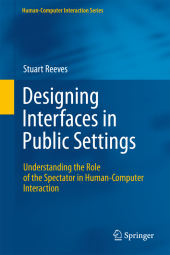 Neuerscheinungen 2013Stand: 2020-01-07 |
Schnellsuche
ISBN/Stichwort/Autor
|
Herderstraße 10
10625 Berlin
Tel.: 030 315 714 16
Fax 030 315 714 14
info@buchspektrum.de |

Stuart Reeves
Designing Interfaces in Public Settings
Understanding the Role of the Spectator in Human-Computer Interaction
Repr. d. Ausg. v. 2011. 2013. xii, 196 S. 52 SW-Abb. 235 mm
Verlag/Jahr: SPRINGER, BERLIN 2013
ISBN: 1-447-12622-X (144712622X)
Neue ISBN: 978-1-447-12622-5 (9781447126225)
Preis und Lieferzeit: Bitte klicken
As ever more interactive computer displays come on stream in museums, performance venues and even on city streets, this book documents the design issues emerging from the changing role of technology and provides practical solutions to design challenges.
Interaction with computers is becoming an increasingly ubiquitous and public affair. With more and more interactive digital systems being deployed in places such as museums, city streets and performance venues, understanding how to design for them is becoming ever more pertinent. Crafting interactions for these public settings raises a host of new challenges for human-computer interaction, widening the focus of design from concern about an individual´s dialogue with an interface to also consider the ways in which interaction affects and is affected by spectators and bystanders.
Designing Interfaces in Public Settings takes a performative perspective on interaction, exploring a series of empirical studies of technology at work in public performance environments. From interactive storytelling to mobile devices on city streets, from digital telemetry systems on fairground rides to augmented reality installation interactive, the book documents the design issues emerging from the changing role of technology as it pushes out into our everyday lives.
Building a design framework from these studies and the growing body of literature examining public technologies, this book provides a new perspective for understanding human-computer interaction. Mapping out this new and challenging design space, Designing Interfaces in Public Settings offers both conceptual understandings and practical strategies for interaction design practitioners, artists working with technology, and computer scientists.
Introduction.-Core Framework Concepts.-An Overview of Study Chapters.-From Individuals to Third Parties, from Private to Public.-Studying Technology in Public Settings.-Individuals to Third Parties.-Private to Public Settings.-Revisiting Opening Questions.-Studying Technology in Public Settings.-Concepts for Understanding Public Settings.-Practical Approaches to Studying Public Settings.-Relating Studies and Framework.-References.-Audience and Participants: One Rock.-Telescope Hardware and Software.-Telescope Design, Constraints and Aesthetics.-The Telescope in Use.-Discussion.-Professionals and Non-Professionals: The Journey into Space.-Other System Deployments.-Storytelling with the Torch Interface.-Discussion.-Summary.-References.-Orchestration and Staging: Fairground: Thrill Laboratory.-Running and Experiencing the Laboratory.-Discussion.-Summary.-References.-Frames and Bystanders: Uncle Roy All Around You.-Performing Uncle Roy.-Discussion.-Summary.-References.-A Framework for Designing Interfaces in Public Settings.-Performers and Spectators, Manipulation and Effects.-Revisiting Public and Private Interaction,-Frames, Audience, Bystanders and Wittingness.-Dynamism in Performance: Transitions.-Summary.-References.-Conclusion.-References.-Index


